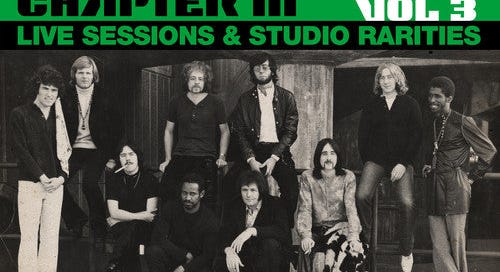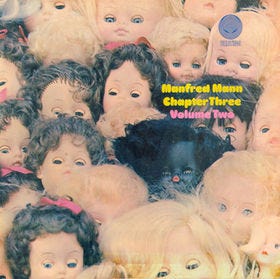From Manfred Mann Chapter Three – Lady Ace (from the Album, Volume Two) First posted September 14, 2014
If you read descriptions of Manfred Mann Chapter III (all of that is the name of a band), you would expect atonal free jazz freakouts. If you listen to their records, you hear some good 60s rock songs played by a normal sounding rock band with a horn section of the sort that was used on Rubber Soul and Sgt. Pepper with a singer who sounds like a sort of miniature Dr. John the Night Tripper and the occasional brief horn solo that sometimes goes free jazz. The sound of the records is like a sort of pop version of Dr. John's Gris Gris album (a great favorite of mine), slow and spooky but with some good tunes. Manfred Mann Chapter 3 was ignored then and now but I think their two albums are a lot of fun.
Manfred Mann was one of the big mid-60s English rock bands. They had a sort of vague image, probably for a variety of reasons. First, the band member named Manfred Mann (real name Manfred Liebovitz – I have seen him referred to as Mike Liebovitz but can't find confirmation of that) was not the band leader, singer or songwriter. Second, the band replaced the lead singer (and changed record companies) right in the middle of their run of hits. Also, they relied on outside writers for most of their material even though various band members had written large hits for others. Finally, thanks to the organ player having the same name as the band, later bands he had, although having almost nothing to do with the original band (Manfred switched over to primarily playing synthesizer), had “Manfred Mann” in their names. Although their R&B covers were quite good (Do Wah Diddy Diddy and Pretty Flamingo both still sound just fine), a quick search of You Tube will turn up clips of the band prancing around like Herman's Hermits, grinning through sing-song ditties with little flute flourishes. I don't think that kind of stuff has held up as well as their others.
Nevertheless, the band was usually viewed as a quality proposition. In addition to the good records they made, they included many high quality musicians and they were actually part of the original beat groups scene. The first version of the group was the Mann-Hugg Blues Brothers. Mike Hugg, the drummer, had previously led a jazz combo which included the legendary Graham Bond, whose later Graham Bond Organization was where Ginger Baker met and hated Jack Bruce (later a member of Manfred Mann briefly), the two of them later to resume hating each other in Cream. Paul Jones, originally known as Paul Pond, along with Tom McGuinness (later a member of Manfred Mann) and Elmo Lewis (later to start the Rolling Stones using his real name, Brian Jones) had been rehearsing a blues band. After going through some other bands and names, Jones (the Paul one) became singer and harmonica player of the Mann-Hugg Blues Brothers in 1962. The record company persuaded them, against everyone's objections, to rename the band Manfred Mann and hits resulted. After a few years of the above-mentioned chirpy and non-chirpy pop hits, Jones left and was replaced by Mike D'Abo (author of later Rod Stewart hit, Handbags to Gladrags and other songs) and the hits, chirpy and non-chirpy, continued (their version of Bob Dylan's Mighty Quinn being one of those later hits - Bob Dylan said he liked it).
By 1969, Mann and Hugg were heartily sick of the Manfred Mann band's pop music. They wanted to get back to some jazz content so they put together a new band that would feature horns and no guitar (they ended up using a little guitar but it was never featured). While they initially called it Emanon, by the time an album was released, at the end of the year, the new group was called Manfred Mann Chapter III. Mike Hugg, who had been the drummer of Manfred Mann's first two “chapters”, moved over to electric piano and became the lead singer. Manfred Mann played organ. Everybody else was new to the band, including a large horn section that didn't play every show but did feature on the records and did make many of the shows. The arrangements usually featured the wind instruments playing large blocks of sound with few inner parts that stood out, with one person stepping out for a solo in each piece. On the second album (called “Volume 2”) there is one long number that somewhat resembles a Sun Ra piece but, really, this is mostly pop music with some unusual sounding arrangements. I think the first album is a little more consistent but Lady Ace, from the second, is a good representative of the band's sound. Both albums were completely made up of original material, including, on the first, You're a Better Man Than I, a Mike Hugg song that the Yardbirds had previously released successfully. I'm also especially fond of Virginia, one of their simplest tunes, that ends the second album.
But Manfred Mann Chapter III didn't sound much like Herman's Hermits so some of the fans hated it. Even more of the fans never heard it because the reviews made it sound like unrelenting blasts of noise. Unrelenting blasts of noise were having one of their infrequent bouts of relative popularity then but not among people who were likely to listen to Manfred Mann and the people who would have liked its new sounds (which were hardly blasts of noise, relenting or not) didn't think to check Manfred Mann for adventurous pop music.
Lady Ace, in its structure, kind of represents the double intentions of the Chapter Three band. After the verse, there is a sung chorus and then there is an instrumental chorus, each chorus having different music. Both choruses are heard after each verse. Where the guitar solo or bridge would go, there is an expanded version of the instrumental chorus with the rhythm section playing in double time. This ratchets up the energy level and a saxophonist blasts off into a pretty much free solo (probably Bernie Living on alto) over a one chord vamp. After the instrumental chorus repeats, everything returns to the normal tempo for the last verse, with the song ending on a mellow, tonal trumpet solo (by Sonny Corbett). Both of the choruses are tuneful so, even with a somewhat free jazz solo in the middle, the effect of the song is pop music. It just now struck me, for the first time, that this music reminds me of King Crimson. Why? King Crimson relied on loud electric guitar for much of its sound and Chapter Three's horns gave it its dominant colors. Maybe it's the vague air of gloom that the instrumental sounds evoke. But even with their plodding tempos and doom laden horns, Chapter Three's songs were almost all pretty catchy. It was a peculiar sounding pop group but most definitely a pop group.
After two albums, Hugg and Mann went their separate ways. A couple years later the (Young) Rascals tried the same thing although their new music was sunnier and peaceful. They also jettisoned some long time members and added some real jazz players but their jazz rock didn't take off either. Manfred Mann put together a new pop group, Manfred Mann's Earth Band, and Hugg made a few records featuring his strange yet appealing voice (and his songwriting). I remember liking them but haven't listened to them for a few decades. I'll get to that.
Hear this song on YouTube:
I uploaded this MP3 made from my old 1979 CD reissue. There is a newer remaster available now but I prefer the sound of the older one. The new version has pumped up the bass but the whole thing sounds somewhat murkier than the the older version. I would compare both to the LP but that is in storage limbo, probably somewhere near the Hugg albums.






